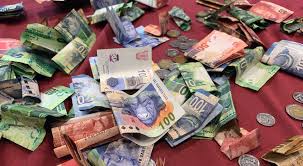The South African rand slipped slightly on Tuesday morning as global investors became more cautious, with ongoing tensions in the Middle East continuing to shake financial markets. As of 06:26 GMT, the rand was trading at 17.83 against the U.S. dollar, showing a 0.1% decline compared to Monday’s closing rate.
This development reflects a broader global trend where investors are pulling away from emerging market currencies due to uncertainty and growing fears of an escalation in the Israel-Iran conflict, now in its fifth day.
Analysts say global investors are currently rushing towards safe-haven assets like the U.S. dollar, gold, and Treasury bonds, due to the rising geopolitical risk in the Middle East. According to reports, former U.S. President Donald Trump’s public call on Iranians to evacuate Tehran has further heightened fears of a direct military confrontation, leading investors to avoid riskier assets like the South African rand.
The fragile risk sentiment is not only hurting South Africa’s currency but also impacting its local bond market. The country’s benchmark 2035 government bond weakened in early trading, with its yield climbing by 1.5 basis points to 10.155%. When bond yields rise, it typically indicates investors are demanding higher returns to hold the risk, another sign of shaky confidence.
While the global picture is gloomy, local developments in South Africa are also being closely watched. Investors are eyeing key economic data releases this week, including consumer inflation figures and retail sales data expected on Wednesday. These numbers could offer hints on the health of the South African economy and influence how the South African Reserve Bank (SARB) moves forward on interest rates.
The SARB’s next monetary policy meeting is scheduled for late July, and markets are already speculating whether the central bank will adjust its stance amid persistent inflation pressures and slow growth. Any signs that inflation is staying high could raise the chances of a rate hike, which might support the rand temporarily.
However, with external shocks dominating investor sentiment, even strong local data may not be enough to reverse the rand’s current trend. South Africa has already experienced heavy foreign outflows from its equity and bond markets this year, as investors grow cautious due to both global risks and domestic uncertainty over policy and governance.
In the past week, the Israel-Iran standoff has been a central concern for financial markets worldwide. Both countries have launched direct attacks on each other’s territory in an escalation unseen in decades. The global energy markets are also on edge due to fears that the conflict could disrupt oil flows through the Strait of Hormuz, a key global shipping lane.
These rising tensions have prompted renewed buying of the U.S. dollar, often viewed as the world’s safest asset. For emerging markets like South Africa, this typically translates into currency pressure and capital flight as investors re-balance their portfolios in favour of lower-risk options.
Experts warn that if the conflict drags on or escalates further, currencies like the rand may face more volatility in the coming days and weeks. At the same time, global economic players are watching carefully for any signs of diplomatic intervention, which could ease tensions and help calm financial markets.
Until then, South Africa’s currency, like many others in the developing world, will remain vulnerable to headlines coming out of the Middle East and Wall Street.
